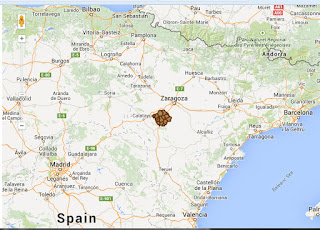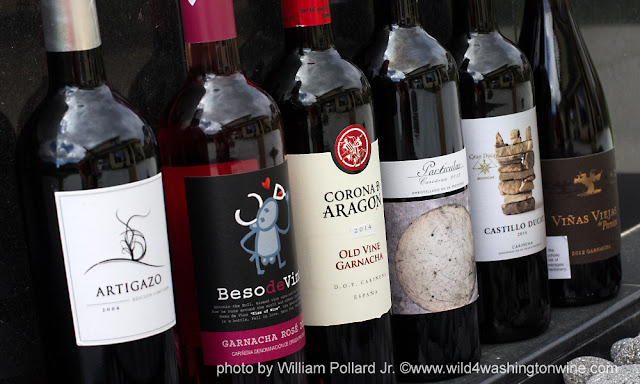My regular readers know how fond I am of Spanish wines and the reasons for my Spanish wine fixation. I'm happy to share with you a recent wine tasting experience exploring the growing region of D.O. Cariñena in Aragon, Spain. Protocol Wine Studio hosted this special tasting of six wonderful Spanish wines.
 |
| Map - Location of D.O. Cariñena. |
About D.O. Cariñena
Cariñena is the second Denomination of Origin (D.O.) of Spain. The regional capital, Zaragoza, is halfway between Madrid and Barcelona and just two hours from France. The climate is continental, Grenache, Tempranillo, and Macabeo are the predominant varieties grown, along with the indigenous Cariñena variety. Also grown are Merlot, Syrah, Cabernet Sauvignon and Chardonnay.
 |
| Bodegas San Valero vines growing in rocks. |
Vineyards range in altitudes from 1,300 – 2,600 foot elevations. The terroir is what makes this region unique, with ancient stony soils. Larger stones help retain soil humidity, while the outer stones irradiate light and heat to the lower parts of the vines, which improves ripening.
Note: Cariñena is the home of the Cariñena grape (Carignan); it is likely the genetic home of Garnacha too.
Note: The Cariñena region has more old vines of Garnacha planted than any other region in Spain, with over 1,600 growers.
The vineyards of Aragon have their origins in the Celtiberian region, the location of the Roman villa of Caræ (now known as Cariñena). Romans founded the city of Caræ in 50 BC in an area where the local population had been producing mead since the 3rd century BC.
In 1909, King Alfonso XIII of Spain awarded Cariñena with the title of Town because of its arduous efforts in the recovery of vineyards affected by Phyloxera, a disease that devastated vineyards across Europe at the end of the 19th century.
In 1932, Cariñena obtained the first Designation of Origin in the Aragon region.
2011 saw the launch of the D.O.'s new campaign and slogan: "The wine of stones". A message that aims at marking the difference between Cariñena and other wines and denominations of origin, based on typical soil features in the area, as well as how stony land can be used to grow wonderful vines.
 |
| 75 - 100 year old vines D.O. Cariñena. |
Note: Co-ops are a popular trend and a way for small growers to make good wine, and preserve old vineyards. Three Co-ops make the majority of Cariñena garnacha. The three major wineries are Bodegas Paniza, Bodegas San Valero and Grandes Vinos y Viñedos. All make "old vine" wine from vineyards which are 50-100 years old.
Tasting Notes Session One - Grandes Vinos y Viñedos
Producing 10 lines of wines, the Grandes Vinos y Viñedos co-op works with growers in all 14 growing regions of D.O. Cariñena.
1. Beso de Vino Garnacha Rose' 2014
Note: Antonio the Bull kissed this wine and he fell in love. Now he runs around the world and offers this wine to you. Beso de Vino “Kiss of Wine”.
Color: Watermelon water.
Nose: Delicate strawberry, hit of earthiness, with air perfumed ozone.
Palate: Almost seemed sweet on first sip, vibrant on the tongue, focused, fresh cherry, strawberry skin, good weight, good texture, pleasantly dry on the gums, raspberry/strawberry into the lingering finish. My speed.
Day two: Enjoyable, creamy fruit, gently dry, cherry/strawberry, balanced and still fresh. Paired with coconut chicken curry and beef carnitas. Good match.
Thoughts: Balanced and tasty. Pleasure in mouth. Can you say BBQ? More serious than expected and a lot of fun. Very good value. Recommended.
D.O. Cariñena
Blend: 100% Garnacha/Grenache
SRP: $10
Closure: Screw cap
ABV: 13%
www.grandesvinos.com
www.besodevino.com
Sourced from 40 year old vines planted at 1,300 – 1,600 feet in pebble-limestone soils.
2. Corona D Aragon 2014 Old Vine Garnacha
Color: Dark garnet.
Nose: Spicy plum, graphite, perfume, stewed cherry. Almond. Dusty.
Palate: Creamy mouth feel, spicy, dark, dry, focused to front, tar, blueberry compote, pleasantly dry on gums, with air moved to mid-palate and dry tannin on tongue. Orange appeared on the lingering finish
After 25 minutes: Implied sweet fruit because of youth and only 4 months in barrel. Tastes like summer days and parties with friends.
Day two: Still smooth and easy drinking. Fruit driven wine with modest tannin on the tongue and fresh finish.
Thoughts: An uncomplicated, fun wine. Pair with food and company. Big Bang for Bucks! Recommended.
Blend: 100% Garnacha/Grenache
Closure: Nomacorc
ABV: 13.5%
SRP: $10
www.grandesvinos.com
http://www.lacoronadearagon.es/en/index.php
2014 Corona de Aragón Old Vine Garnacha - Sourced from the oldest vines in the Villanueva de Huerva region. Villanueva de Huerva is the most remote and highest region in the Cariñena D.O. and barely accessible due to its slope terrain which is suitable for cultivating vines under a terrace technique. The vineyards are 45 years old.
Producing 10 lines of wines, the Grandes Vinos y Viñedos co-op works with growers in all 14 growing regions of D.O. Cariñena. http://www.grandesvinos.com/english/vinos/index.php
Tasting Notes Session Two - Bodegas San Valero
Founded in 1944 by 60 winegrowers from the Cariñena region who mainly made bulk wine. Today,
Bodegas San Valero has more than 700 members in its cooperative.
3. Castillo Ducay 2014 Red
Color: Vivid violet to beet red.
Nose: Fruit driven, licorice, rose petal.
Palate: Tart, bitter middle of palate, raw cherry, dry, raspberry brightness on tangy finish. With air opened up with some cherry/orange, less tangy, and more appealing. Aerated this wine, expressed chocolate, smoother, no longer tangy, a little orange floral, yes, improved for me.
After 45 minutes: Strawberry on the palate, drank fresh and fruity, enjoyable but would be better chilled. After an hour cherry Kool-Aid on nose and finish.
After 3 hours: Soft and fruity, spice, dark notes, gently dry, cherry Kool-aid on the friendly finish. Serve up chilled and enjoy on a hot day.
Thoughts: Serve chilled for such a young, fruit driven wine. It was suggested to pair with salty foods. Believe this may be best suited to real BBQ or a large fruit plate. Fun change of pace. Drink now. Recommended.
Blend: Garnarcha 60%, Tempranillo 30%, Cabernet Sauvignon 10%
Closure: Micro-Aglomerated Cork
ABV: 13%
Bodegas San Valero
The grapes for this wine are grown at 2,100 feet from 15 to 20 year old vines.
4. Particular 2013 Cariñena
Color: Dark plum.
Nose: Herbal tang, black tea, dark cherry skin, clove.
Palate: Smooth, dry, tarragon, black cherry, dried out tongue and gums, lovely grip, clove and chocolate on lingering dry finish. Yum. With the aerator, smooth mushroom, still very grippy, tar, chocolate, tangy ripe cherry, rockiness/mineral and clove on the finish.
After 3 hours: Savory, a bit more integrated and not as dry.
Thoughts: Interesting wine, good for grilled steak and anything with fat. A recommended food wine. Drink now and over next 3 years. Strongly Recommended.
Blend: 100% Cariñena
Closure: Natural cork
ABV: 14%
Bodegas San Valero
Tasting Notes Session Three - Bodegas Paniza
Founded in 1953, Bodegas Paniza is named for the village where the winery is located. The winery is situated in the highest elevation of the D.O.P. Cariñena. Paniza is made up of a cooperative of 400 growers and 6,200 acres. Up to 100 year old vines, planted in slate soils, above 850m elevation.
5. Vinas Viejas de Paniza, 2012 Garnacha
Color: Dark Plum.
Nose: Candied cherry, floral, spice, slate background.
Palate: Fruit focused forward, creamy, lacking tannin at first. After 7 minutes, pow, tannin. Nice finish. Creamy, spicy Bing cherry finish.
Nose opened at 25 minutes, fruity, spicy finish.
At 50 minutes: Showed off on the palate.
Thoughts: Very good with fried steak. Would be wonderful at restaurants because it is so food friendly. Strongly Recommended.
Blend: 100% Garnacha/Grenache
Closure: Agglomerated Cork
ABV: 14%
SRP: $18
www.bodegaspaniza.com
6. Artigazo 2008 Edicion Limitada –
Unfortunately, I was the one lucky person to receive a corked bottle of this wine. My compatriots said it was delicious. Cool label design. Sigh.
Blend: 40% Garnacha, 30% Syrah, 30% Cabernet Sauvignon
ABV: 14.5%
www.bodegaspaniza.com
Summary
Cariñena is not as well known a growing region as regions to the north like Ribera del Duero and Rioja, nor is it as popular as Priorat and Toro. Which means you can find some wonderful value in Cariñena wines. If you enjoy food worthy red wine and rose' I recommend you seek out these wines.
Web Resources
- DOP Cariñena - Spain - English site
- Wines of Stone DO Cariñena - English
- Book Wines From Spain
About Protocol Wine Studio
Protocol Wine Studio hosted the #WineStudio session on Cariñena wines. Protocol Wine Studio is all about wine education, thus a better understanding of our world via wine and our part in that world. You can follow along with our tweets on Tuesday evenings at 6 pm Pacific.
Lyn Farmer, James Beard Award-winning wine and food writer, WSET Instructor, arts educator and public speaker experienced the Cariñena region last June. He shared with us his insights into the history, sights, sounds and tastes that is Cariñena.
Cheers!









